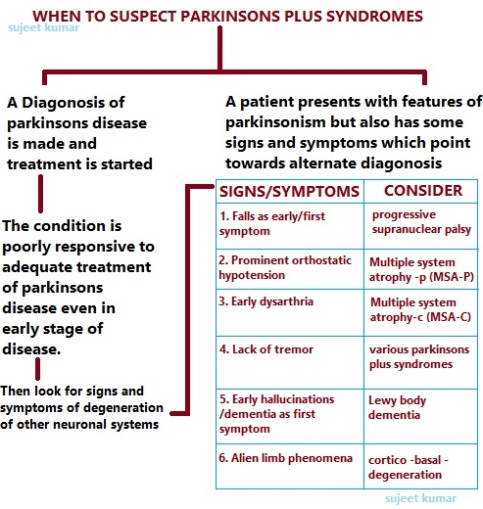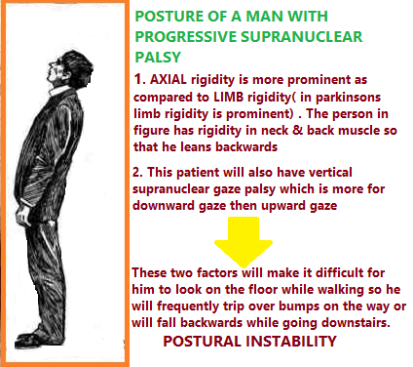Parkinsons plus syndromes have features of parkinsonism but they differ from parkinsons disease in having some additional features and they r unresponsive to treatments directed against parkinsons disease.
NOW LETS SEE HOW THEY COME TO NOTICE :
EXAMPLES of PARKINSONS PLUS SYNDROMES r ;
1] Multiple system atrophy
2] Progressive supranuclear palsy
3] Parkinsonism-dementia-amyotrophic lateral sclerosis comple
4] Corticobasal ganglionic degeneration
PROGRESSIVE SUPRANUCLEAR PALSY
It is a tauopathy due to deposition of tau doublet 64 ,69.
CLINICAL FINDINGS:
1. Tremor is rare.
2. Supra nuclear vertical gaze palsy : supra nuclear nature of palsy can be checked by presence of vestibulo-ocular reflex which can be clinically assesed by vertical dolls eye maneuvers . There will be slowing of verical saccades.
3. presence of square wave jerks ( Square-Wave Jerks (SWJ) are inappropriate saccades that take the eye off the target, followed by a nearly normal intersaccadic interval and then a corrective saccade that brings the eye back to the target.).These are fine movements, that can be mistaken for nystagmus, except that they are saccadic in nature, with no smooth phase.
4. Akinetic rigid syndrome = axial rigidity > limb rigidity
This instability leads to frequent backwards fall……and patient makes very little effort to prevent the fall….
COMBINATION OF VERTICAL SUPRANUCLEAR GAZE PALSY AND HISTORY OF FREQUENT FALL ( ESPECIALY BACKWARDS) IS CENTRAL TO DIAGONOSIS OF PSP
5. Dementia and frontal lobe signs as apathy , personality changes , disinhibition may be present.
IT HAS TWO TYPES ;
[A] STEEL RICHARDSON SYNDROME = EARLY POSTURAL INSTABILITY + COGNITIVE DYSFUNCTION + SUPRA NUCLEAR GAZE PALSY
[B] PSP PARKINSONISM = PREDOMINANT FEATURES OF TYPICAL PD AND IT IS MODERATELY RESPONSIVE TO LEVADOPA+CABIDOPA
NOTE : (1) HPE shows deposition of GLOBOSE NEUROFIBRILLARY TANGLES & TUFTED ASTROCYTES . (2) MRI shows HUMMING BIRD SIGN which is due to atrophied mid brain and relatively preserved pons
u can also read basal ganglia and parkinsonoism aon following link
http://pguploads.com/2013/03/23/parkinsonism-a-story-of-muhammad-alis-basal-ganglia/



